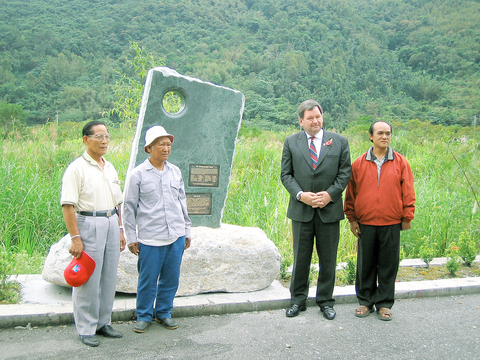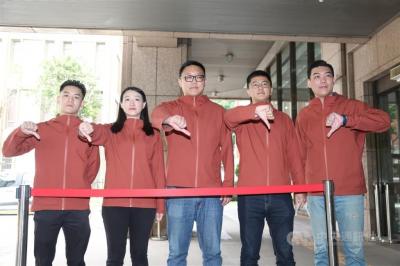More than half a century after a British reconnaissance aircraft crashed at Mt. Yuli in Hualien County, killing all 14 airmen onboard, a memorial service took place on Monday to finally honor the deaths of these long forgotten soldiers whose remains were buried in the thick jungle of the immediate crash site.
The aircraft, a Sunderland PP 107 flying boat from the Royal Air Force's (RAF) No. 205 Squadron, had been flying from an RAF base at Iwakuni, near Yokohama, Japan, to Hong Kong on Jan. 28, 1951, on a support mission for the UN Command during the Korean War.
It crashed into Mt. Yuli at an altitude of around 1,600m after a navigational error made during bad weather, killing all 14 personnel onboard, including 7 RAF aircrew and another 7 ground crew. The bodies of the crew were never repatriated.

PHOTO COURTESY OF THE BRITISH TRADE AND CULTURAL OFFICE.
On Monday, the British Trade and Cultural Office (BTCO) erected a memorial near the crash site to honor the sacrifice made by these 14 British servicemen to coincide with Remembrance Sunday, the annual British day for mourning lost soldiers.
Derek Marsh, the director-general of the BTCO, and Simon Coy OBE, a former group captain in the RAF and now the Cornwall County president of the Royal British Legion, were the initiators of the memorial project, which took them nearly three years to complete through collaboration with local Aborigines, some of whom witnessed the crash 54 years ago.
Reconnaissance mission
Although it is not known whether any of those killed originated from Cornwall, Coy believes it is probable, given that a number of units based at RAF St. Mawgan and RAF St. Eval, Cornwall, were involved in maritime reconnaissance.
The Sunderland PP 107 flying boat was one of several British surveillance planes supporting UN and US naval operations against North Korea during the Korean War. Their main job was to provide surveillance over both coasts of the Korean peninsula and locate any North Korean ships or submarines. The anti-submarine flying boat was based in Singapore and every six weeks or so would fly back to the island-state for maintenance. The regular flight pattern involved breaking the journey in Hong Kong.
Out of the total of 14 airmen, all in their early 20s, the seven members of the flight crew included the two pilots, a navigator, an engineer, a wireless operator and two weapons systems operators, while the other seven were ground crew who were returning to Singapore to make way for replacements.
"They were going home. It was the end of their six-month tour, but they never got home. It's very sad because their families would have been waiting for them to come home after six long months. Many of the men wouldn't have been married, but some were," Coy said in an interview with the Taipei Times last week.
He flew from Britain especially to attend Monday's memorial service.
The remains of the airmen were never recovered due to the inaccessibility of the site and the mountainous terrain, as the plane crashed high above Chungping Village (中平), in Hualien's Chuohsi Township (卓溪).
"It crashed into the thick jungle on the mountainside and then exploded," recalled Huang Sheng-he (黃勝和), an 80-year old Bunun Aboriginal hunter who witnessed the crash and was involved in rescue efforts 54 years ago.
Huang, 25 at the time, said he heard a huge explosion as the plane crashed. The local police mobilized the villagers to help with rescue efforts but because of the difficult conditions, the bodies were simply buried under leaves on the side of the mountain. Later, many of the airplane's components, including twisted pieces of metal and the frame, were taken away and sold by local businessmen.
After the crash, the site became a no-go area for local Aboriginal hunters as they believed it was haunted by the ghosts of the dead servicemen.
Marsh, who scaled the mountain last April with the assistance of the Aborigines, said "the villagers themselves were very concerned about the ghosts at the crash site and they don't particularly like going back there."
Western ghosts
The local villagers, according to their native customs, are in great awe of spirits, and on this occasion they were particularly afraid because "Western ghosts tend to be bigger than Chinese ghosts," Marsh said.
After receiving Marsh's request, the local villagers accompanied him on his trip to the crash site in April last year. It was the first time that they had been back in 53 years.
Curiously enough, it was as if the spirits were actually there, Marsh said, for the tribesmen told him that they felt they were directed to the scene of the crash.
"The first time they attempted to look for the site, they couldn't find it. Then on the second occasion, they found it. The old guy said to me that he felt they were guided. `Somebody actually guided us to the site,'" Marsh said.
Later, the Aborigines managed to find a few pieces of the airplane scattered around the jungle, including engine parts, wires, perspex from the windows and small pieces of the aluminum and magnesium frame.
Marsh didn't manage to reach the site himself, as it was much further then he had expected. There were no trails and the steep slippery conditions meant that he fell over several times.
"Every time I tripped over, the guide would warn me to watch out for snakes. One time there really was a bamboo snake on the tree just above my head," said Marsh, whose legs were also attacked by leeches during the hike.
The initiative to erect the memorial was started by Marsh and Coy, who had served together in the British embassy in Seoul. Three years ago, the two men had set out to try to find out about the 14 missing servicemen, whose names they had found listed in the UN Command Cemetery in Busan, South Korea. A total of 1,139 British servicemen died during the Korean War, 30 of them from the air force.
At the time of the crash, the British government carried out an official inquiry as to its cause, but it was not the policy of the air force at the time to repatriate bodies of dead servicemen.
Too many casualties
Coy explained that at the time, because of the large number of casualties during the war, the government simply didn't have the desire to risk more men in trying to find the remains of every serviceman killed in action.
Coy added that as the accident happened at a time when British servicemen were operating on several fronts around the world it was just not possible to commemorate them all. It was unfortunate that the accident happened after 1946, when responsibility for graves and memorials had already passed from the Commonwealth War Graves Commission to the Air Ministry, and they took no action at the time.
However, Coy said that now there is a different mood in the country, with demands that all sacrifices which were not marked at the time be commemorated in some way.
The memorial was erected on Monday at the public cemetery tower, overlooking the crash site on Mt. Yuli.
Marsh and Coy laid poppy wreaths at the memorial and carried out a remembrance service as practiced on Remembrance Sunday by churches across the UK.
"We remember with thanks and sorrow all those whose lives have been given and taken away in world wars and conflicts past and present," Coy said in his remembrance passage, concluding the work that helped the lost airmen to finally rest in peace.

Taiwan is stepping up plans to create self-sufficient supply chains for combat drones and increase foreign orders from the US to counter China’s numerical superiority, a defense official said on Saturday. Commenting on condition of anonymity, the official said the nation’s armed forces are in agreement with US Admiral Samuel Paparo’s assessment that Taiwan’s military must be prepared to turn the nation’s waters into a “hellscape” for the Chinese People’s Liberation Army (PLA). Paparo, the commander of the US Indo-Pacific Command, reiterated the concept during a Congressional hearing in Washington on Wednesday. He first coined the term in a security conference last

Prosecutors today declined to say who was questioned regarding alleged forgery on petitions to recall Democratic Progressive Party (DPP) legislators, after Chinese-language media earlier reported that members of the Chinese Nationalist Party (KMT) Youth League were brought in for questioning. The Ministry of Justice Investigation Bureau confirmed that two people had been questioned, but did not disclose any further information about the ongoing investigation. KMT Youth League members Lee Hsiao-liang (李孝亮) and Liu Szu-yin (劉思吟) — who are leading the effort to recall DPP caucus chief executive Rosalia Wu (吳思瑤) and Legislator Wu Pei-yi (吳沛憶) — both posted on Facebook saying: “I

The Ministry of Economic Affairs has fined Taobao NT$1.2 million (US$36,912) for advertisements that exceed its approved business scope, requiring the Chinese e-commerce platform to make corrections in the first half of this year or its license may be revoked. Lawmakers have called for stricter enforcement of Chinese e-commerce platforms and measures to prevent China from laundering its goods through Taiwan in response to US President Donald Trump’s heavy tariffs on China. The Legislative Yuan’s Finance Committee met today to discuss policies to prevent China from dumping goods in Taiwan, inviting government agencies to report. Democratic Progressive Party Legislator Kuo Kuo-wen (郭國文) said

The Ministry of Economic Affairs has fined Taobao NT$1.2 million (US$36,900) for advertisements that exceeded its approved business scope and ordered the Chinese e-commerce platform to make corrections in the first half of this year or its license would be revoked. Lawmakers have called for stricter supervision of Chinese e-commerce platforms and more stringent measures to prevent China from laundering its goods through Taiwan as US President Donald Trump’s administration cracks down on origin laundering. The legislature’s Finance Committee yesterday met to discuss policies to prevent China from dumping goods in Taiwan, inviting government agencies to report on the matter. Democratic Progressive Party